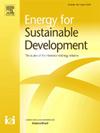Modelling of rooftop photovoltaic systems for electrification of public schools in developing countries
IF 4.9
2区 工程技术
Q2 ENERGY & FUELS
引用次数: 0
Abstract
The present work investigates the techno-economic-spatial-environmental feasibility of a Rooftop Photovoltaic System (RTPVS) for electrification of a grid outage-ridden, space-restricted public school in Sikkim, India and the techno-economic impact of electric cooking (e-cooking) against gas cooking to tackle rising Liquified Petroleum Gas (LPG) prices used in Pradhan Mantri Poshan Shakti Nirman (PM POSHAN) scheme, for enhancing student enrolment in public schools. Remote-Areas Multi-energy-systems-load Profiles (RAMP) for load modelling; PVsyst for estimating maximum Photovoltaic panel capacity and optimum Performance Ratio (PR); and HOMER PRO for techno-economic investigation is used. 5 Dispatch Strategies (DSs) are implemented for three RTPVS configurations including two customized HOMER PRO-MATLAB DSs for the grid-connected configurations to understand the impact of employment of advanced and traditional grid-tied and hybrid converters during grid outages. Further, the impacts of transition to energy-efficient appliances, grid unreliability and various sensitivity parameters on the modelled system outcomes are also investigated to generate broader comprehension of the system performance. For unreliable grid, PV-grid-battery configuration with grid sales yields the best feasible result with a lower global warming potential (GWP) and a reduced Levelized Cost of Energy (LCOE) at 0.0548 $/kWh than both the presently implemented grid-diesel generator (DG)-LPG configuration at 0.306 $/kWh and prevalent grid-battery configuration at $0.212 $/kWh, while the standalone PV-battery configuration is also economically competitive at 0.269 $/kWh with the least GWP. The PV-grid-battery configuration also shows economic viability across entire India for various component costs, grid tariffs and climatic conditions. The optimum converter capacity is conflictingly impacted by grid sales and converter costs. The advanced hybrid converter despite their high costs will be economically more viable over traditional hybrid converters in PV-grid-battery configuration for locations with high frequency and duration of grid outages. The charging of batteries via grid is not recommended as it increases LCOE and system GWP. In locations with high grid tariffs and high percentage sellback rates, the PV-grid-battery configurations can be oversized to increase grid sales and system reliability without impacting the economic viability of the configuration. The degradation of Lead Acid Battery (LABs) increases LCOE and GWP. Policy implementation like carbon credits and subsidies on RTPVS and e-cooking appliances equivalent to LPG may further promote the RTPVS and e-cooking adoption in public schools.
发展中国家公立学校电气化屋顶光伏系统建模
目前的工作调查了屋顶光伏系统(RTPVS)的技术-经济-空间-环境可行性,该系统用于印度锡金一所电网中断,空间有限的公立学校的电气化,以及电烹饪(e-cooking)与燃气烹饪的技术-经济影响,以解决Pradhan Mantri Poshan Shakti Nirman (PM Poshan)计划中使用的液化石油气(LPG)价格上涨的问题,以提高公立学校的入学率。用于负荷建模的偏远地区多能源系统负荷剖面(RAMP);pv系统用于估算最大光伏板容量和最佳性能比(PR);采用荷马PRO进行技术经济调查。5调度策略(DSs)实现了三种RTPVS配置,包括两个定制的HOMER PRO-MATLAB DSs用于并网配置,以了解在电网中断期间使用先进和传统并网和混合转换器的影响。此外,还研究了向节能电器过渡、电网不可靠性和各种灵敏度参数对建模系统结果的影响,以更广泛地理解系统性能。对于不可靠的电网,与目前实施的电网-柴油发电机(DG)-液化石油气配置(0.306美元/千瓦时)和普遍的电网电池配置(0.212美元/千瓦时)相比,电网-电网-电池配置与电网销售相比,产生了最佳的可行结果,全球变暖潜势(GWP)较低,平均能源成本(LCOE)为0.0548美元/千瓦时,而独立的光伏电池配置在经济上也具有竞争力,价格为0.269美元/千瓦时,GWP最低。光伏并网电池的配置也显示了在整个印度的各种组件成本、电网关税和气候条件下的经济可行性。最优变流器容量受到电网销售和变流器成本的矛盾影响。尽管这种先进的混合转换器成本高昂,但在光伏-电网-电池配置中,它在经济上比传统的混合转换器更可行,适用于电网中断频率高、持续时间长的地区。不建议通过电网对电池充电,因为这会增加LCOE和系统GWP。在电网电价高、回售率高的地区,可以采用超大尺寸的光伏电网电池配置,以增加电网销量和系统可靠性,同时不影响配置的经济可行性。铅酸蓄电池(lab)的降解提高了LCOE和GWP。碳信用和补贴RTPVS和相当于液化石油气的电子烹饪器具等政策的实施可能会进一步促进RTPVS和电子烹饪在公立学校的采用。
本文章由计算机程序翻译,如有差异,请以英文原文为准。
求助全文
约1分钟内获得全文
求助全文
来源期刊

Energy for Sustainable Development
ENERGY & FUELS-ENERGY & FUELS
CiteScore
8.10
自引率
9.10%
发文量
187
审稿时长
6-12 weeks
期刊介绍:
Published on behalf of the International Energy Initiative, Energy for Sustainable Development is the journal for decision makers, managers, consultants, policy makers, planners and researchers in both government and non-government organizations. It publishes original research and reviews about energy in developing countries, sustainable development, energy resources, technologies, policies and interactions.
 求助内容:
求助内容: 应助结果提醒方式:
应助结果提醒方式:


